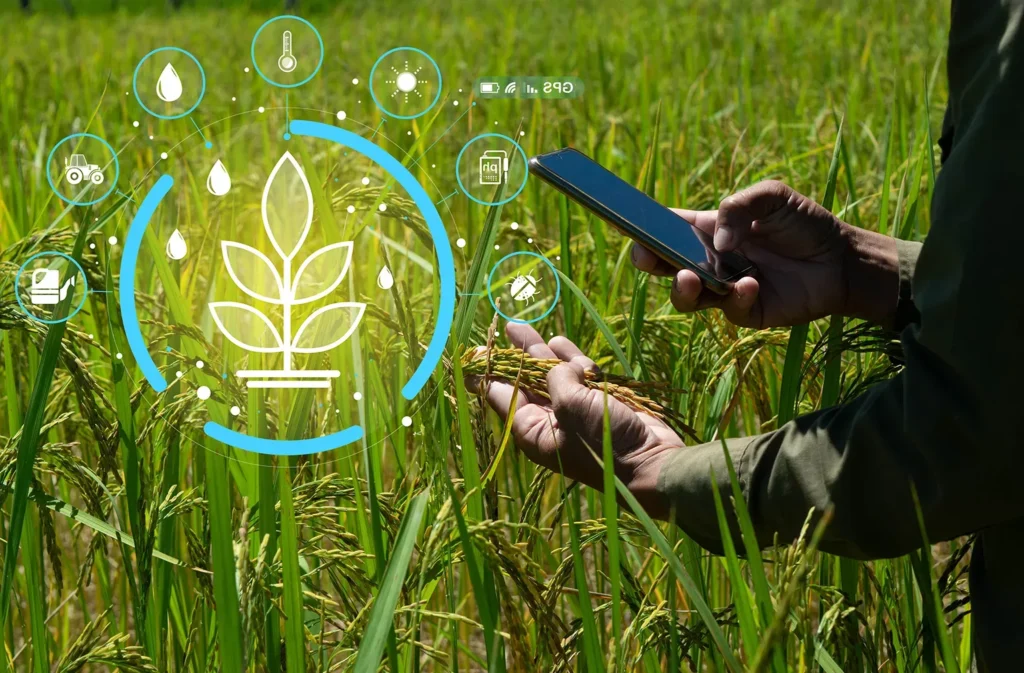Vous avez entendu parler d'outils d'IA comme les capteurs de sol, les drones, les applications météo et les modèles de détection de maladies. Mais en tant que petit agriculteur jonglant avec un temps limité, il est facile de se sentir dépassé par la situation. fragmentation des données provenant de sources multiples.
C'est là que tableaux de bord des données agricoles Entrez.
Un tableau de bord de données agricoles est comme un centre de contrôle numérique— une plateforme unique qui collecte, affiche et interprète toutes vos données agricoles en un seul endroit. Que vous gériez 1 ou 2 hectares, ce système centralisé peut considérablement améliorer votre productivité. améliorer votre prise de décision, vous faire gagner du temps, et augmenter les rendements.
Dans ce guide, nous expliquerons à quoi servent les tableaux de bord, pourquoi ils sont importants pour les petites exploitations, comment en créer un et les meilleurs outils abordables disponibles aujourd'hui.
Qu'est-ce qu'un tableau de bord de données agricoles ?
UN tableau de bord des données agricoles est une interface numérique, accessible sur votre téléphone ou votre ordinateur, qui intègre des données provenant de diverses sources dans votre exploitation, notamment :
- Prévisions météorologiques et capteurs de pluie
- Imagerie par drone et satellite
- Capteurs d'humidité du sol et moniteurs de pH
- Modèles de croissance des cultures et alertes de maladies
- Calendriers de fertilisation et d'irrigation
Au lieu de basculer entre 5 applications ou appareils, vous obtenez un seul écran montrant tout ce que vous devez savoir sur votre ferme.
Pourquoi les petites exploitations agricoles ont besoin de tableaux de bord de données

Les grandes exploitations utilisent des tableaux de bord pour gérer des opérations complexes. Mais les petites exploitations peuvent en tirer encore plus d'avantages : chaque mètre carré compte.
🔍 Real-Time Insights
Les tableaux de bord montrent données en direct depuis votre champ : sachez exactement quand arroser, pulvériser ou récolter.
📉 Reduce Guesswork
Prenez des décisions éclairées appuyées par Prédictions générées par l'IA et des alertes.
⏳ Save Time
Pas besoin de vous connecter à plusieurs applications : les tableaux de bord consolident votre flux de travail.
🌱 Increase Productivity
Sachez quand et où appliquer l’engrais, identifiez les problèmes tôt et surveillez la croissance avec précision.
🌍 Track Sustainability Metrics
Gardez un œil sur les intrants, les émissions et la santé des sols : idéal pour l’agriculture biologique ou intelligente face au climat.
Principales fonctionnalités à rechercher dans un tableau de bord de ferme
Lorsque vous sélectionnez un tableau de bord pour votre petite ferme, recherchez :
| Fonctionnalité | Description |
|---|---|
| Intégration des appareils | Fonctionne avec des drones, des capteurs, des stations météo |
| Accessibilité mobile | Fonctionne sur les smartphones et les tablettes |
| Alertes personnalisées | Pour les parasites, la météo ou les seuils d'irrigation |
| Interface simple | Facile à lire, aucune connaissance technique requise |
| Mode hors ligne | Pour les fermes éloignées avec une connexion Internet médiocre |
| Abordable ou gratuit | Tarification à plusieurs niveaux avec des forfaits gratuits/basiques |
Meilleurs tableaux de bord agricoles pour les petits exploitants (2025)

🟢 1. Agrio
- Idéal pour : Alertes aux maladies et surveillance des cultures
- Plate-forme: iOS, Android, Web
- Coût: Niveau de base gratuit, premium $9,99/mois
- Points forts:
- Détection de maladies par imagerie
- Intégration avec l'imagerie des drones
- Évaluation de la santé des cultures par l'IA
- Pourquoi c'est génial : Idéal pour les agriculteurs utilisant des smartphones sur le terrain
🔵 2. Climate FieldView
- Idéal pour : Cartographie des sols, de la météo et des rendements
- Plate-forme: Web, iOS
- Coût: Essai gratuit, abonnement à partir de $99/an
- Points forts:
- Cartes de terrain en couches
- S'intègre avec John Deere, DJI, etc.
- Recommandations basées sur l'IA
- Pourquoi c'est génial : L'un des tableaux de bord agricoles les plus robustes, même pour les petites exploitations
🟠 3. FarmLogs
- Idéal pour : Petits exploitants soucieux de leur budget
- Plate-forme: iOS, Android, Web
- Coût: Version de base gratuite, $29/mois Pro
- Points forts:
- Outils simples de planification des cultures
- Alertes sols et météo
- Journalisation des activités
- Pourquoi c'est génial : Facile à utiliser et abordable
🔴 4. MyFarmBot (option open source)
- Idéal pour : Agriculteurs férus de technologie ou bricoleurs
- Plate-forme: Web
- Coût: Gratuit (auto-hébergé)
- Points forts:
- Personnalisez avec vos propres capteurs
- Idéal pour les fermes expérimentales
- Pourquoi c'est génial : Contrôle total et aucun lien avec un fournisseur
🟡 5. OneSoil
- Idéal pour : Cartographie de terrain sans équipement
- Plate-forme: Web, iOS
- Coût: Gratuit
- Points forts:
- Utilise des données satellite gratuites
- Suivi des cultures et prévision des rendements
- Aucun matériel nécessaire
- Pourquoi c'est génial : Aucun coût d'installation, parfait pour les petits exploitants sous-financés
Cas d'utilisation : à quoi ressemble un tableau de bord sur un terrain de 3 acres
Imaginez ceci :
Vous cultivez du gombo, du maïs et du manioc sur 1,2 hectare au Nigéria. Vous avez installé :
- Un capteur d'humidité du sol
- Une station météo
- Un drone de reconnaissance
- Une application pour smartphone contre les nuisibles
Votre tableau de bord peut afficher :
| Métrique | Lectures actuelles | Action |
|---|---|---|
| Humidité du sol | 12% dans la zone maïs | Irriguer demain matin |
| Prévisions météorologiques | Pluie dans 3 jours | Retarder la pulvérisation de pesticides |
| Images de drones | Taches jaunes sur le manioc | Enquêter sur un éventuel problème nutritionnel |
| Alerte aux nuisibles | Risque de thrips détecté | Appliquer de l'huile de neem dans la zone du gombo |
Comment configurer un tableau de bord de données agricoles (étape par étape)
✅ Step 1: Choose a Dashboard Platform
Choisissez parmi FarmLogs, Agrio, OneSoil ou un outil qui correspond à vos besoins.
✅ Step 2: Connect Devices
Reliez votre drone, votre station météo ou votre capteur de sol via Bluetooth, Wi-Fi ou API.
✅ Step 3: Define Field Boundaries
Utilisez l'application ou téléchargez une image satellite pour marquer votre parcelle.
✅ Step 4: Set Alerts
Personnalisez les notifications en fonction de la météo, des parasites ou des seuils de sol.
✅ Step 5: Start Logging Activities
Saisissez les dates de plantation, de fertilisation et de récolte manuellement ou via des capteurs.
Matériel abordable à associer aux tableaux de bord
Pas besoin d'équipement coûteux. Voici quelques options adaptées aux petites exploitations :
| Appareil | Coût | Fonctionne avec |
|---|---|---|
| Capteur de température et d'humidité Xiaomi Mi | ~$15 | MyFarmBot, assistant domestique |
| Caméra TP-Link Tapo (pour portail d'élevage/ferme) | ~$35 | Tableau de bord tiers |
| Drone Parrot Bluegrass | ~$499 utilisé | DroneDeploy, Agrio |
| Capteur de sol Acclima | ~$100 | Climate FieldView, FarmLogs |
Données que vous pouvez suivre dans un tableau de bord agricole
🔸 Crop Health
Utilisez une analyse d’image basée sur l’IA ou des journaux manuels.
🔸 Weather & Microclimate
Tendances des précipitations, de l'humidité et de la température.
🔸 Soil Moisture & Fertility
À partir de capteurs ou de données de terrain historiques.
🔸 Pests & Disease
Alertes d'application, téléchargements d'images ou analyses de drones.
🔸 Inputs & Activities
Suivez ce qui a été appliqué, où et quand.
🔸 Yields & Revenue
Poids des récoltes de grumes et prix du marché.
Le pouvoir des informations prédictives
Les tableaux de bord peuvent faire plus qu’afficher des données : ils peuvent prédire ce qui va arriver ensuite:
- Quand s'attendre à des infestations de ravageurs
- Quelles cultures auront un faible rendement en fonction de la croissance actuelle
- Quand changer le moment de l'irrigation en fonction des tendances météorologiques
- Quand planter ou récolter pour un rendement maximal
C'est l'agriculture IA à son meilleur.accessible et utile même pour la plus petite ferme.
Tirer le meilleur parti de votre tableau de bord
Voici comment obtenir la pleine valeur :
- Utilisez-le chaque semaine – vérifier avant de pulvériser ou d’irriguer
- Fixer des objectifs – comme la réduction des coûts des intrants ou l’amélioration de l’utilisation de l’eau
- Tenir des registres – les données vous aident à mesurer les améliorations
- Famille/personnel du train – donc tout le monde utilise le tableau de bord
- Rejoindre des groupes d'utilisateurs – de nombreuses plateformes ont des communautés Facebook ou WhatsApp
Erreurs courantes à éviter
🚫 Trop d'applications – S’en tenir à 1 ou 2 outils intégrés.
🚫 Ne pas mettre à jour les données – Les tableaux de bord ne sont utiles que s’ils sont alimentés régulièrement.
🚫 Ignorer les alertes – Les notifications personnalisées existent pour une raison !
🚫 Choisir une plateforme complexe – Choisissez quelque chose de simple et adapté à votre niveau de compétence.
Avantages de l'agriculture durable et biologique
Les tableaux de bord de données sont particulièrement utiles pour :
- Documenter une faible utilisation de produits chimiques
- Enregistrement des tendances en matière d'application de compost et de santé des sols
- Suivi des entrées/sorties de carbone
- Prouver la conformité à la certification biologique
Ils sont un allié dans le mouvement vers agriculture régénératrice et intelligente face au climat.
Perspectives d'avenir : la ferme connectée à l'IA du futur
Bientôt, les tableaux de bord deviendront assistants numériques à commande vocale—combinant :
- Prédictions de l'IA
- Recommandations basées sur le chat
- Alertes en temps réel
- Commandes vocales pour les tâches agricoles
Imaginez ceci : « Alexa, montre-moi les niveaux d’humidité du manioc et les alertes de parasites d’aujourd’hui. »
Cet avenir est plus proche que vous ne le pensez, et les petites exploitations agricoles sont invitées.
✅ Your 7-Day Action Plan to Go Digital
| Jour | Tâche |
|---|---|
| Jour 1 | Choisissez une application de tableau de bord (démarrez gratuitement) |
| Jour 2 | Tracez les limites de votre champ |
| Jour 3 | Ajouter des modules de suivi météo et des cultures |
| Jour 4 | Saisie des données du sol (capteur ou manuel) |
| Jour 5 | Téléchargez des images de drone ou de téléphone |
| Jour 6 | Définir des alertes pour l'irrigation et les parasites |
| Jour 7 | Consultez les informations du tableau de bord et planifiez la semaine |
Conclusion : Big Data, petite intrigue
L’IA transforme l’agriculture —pas seulement pour les gros tracteurs et les méga-fermes, mais pour les agriculteurs possédant 1, 2 ou 5 acres.
Les tableaux de bord des données agricoles vous aident visualisez l'ensemble de votre opération en un coup d'œil, prendre rapidement des décisions intelligentes et prenez le contrôle de vos rendements comme jamais auparavant.
Vous n’avez pas besoin d’être ingénieur ou de posséder des milliers de dollars : il vous suffit d’un smartphone, d’un peu de curiosité et de la volonté de devenir plus intelligent.
📖 À venir dans le Des rendements plus intelligents Série:
Chapitre 9 : Agriculture IA à petit budget : construire une ferme intelligente pour moins de 1 TP4T500


